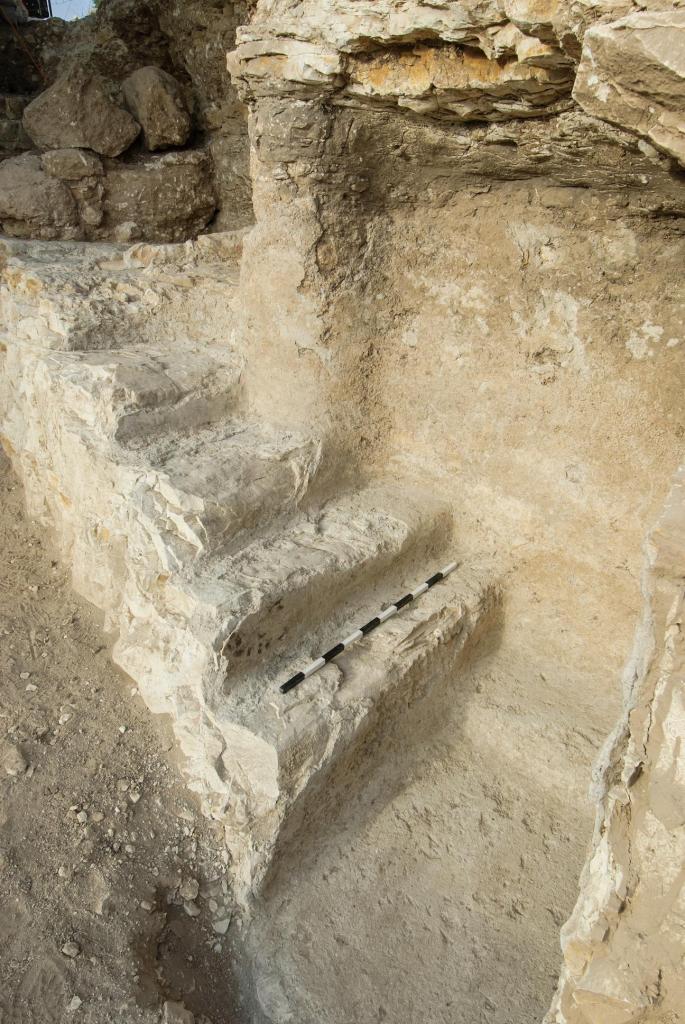Israel’s Antiquities Authority (IAA) demonstrates again Israel’s rich and multi-layered history with a new finding.
A 1700-year-old water cistern. (Photo: Assaf Peretz/IAA)
Archaeologists recently exposed a 1,900-year-old mikvah (ritual bath) near the Ha-Ela Junction, on the road to Jerusalem not far from Beit Shemesh, while excavations to widen Highway 38 were being done.
An enormous 1,700-year-old water cistern was revealed nearby in which graffiti was discovered that had been engraved on the reservoir’s ceiling by Australian soldiers during the Second World War.
According to Yoav Tsur, the IAA excavation director, “We exposed a mikvah in which there are five steps. We found fragments of magnificent pottery vessels there dating to the second century CE, among them lamps, red burnished vessels, a jug and cooking pots. Apparently the mikve ceased to be used during the second century CE, perhaps in light of the Bar Kochba revolt.”
During the course of the excavation, archaeologists were surprised to discover some contemporary, yet intriguing, finds, including graffiti engraved on the ceiling of the cistern indicating the place had been exposed until the 1940s.
WWII Marks
The inscriptions were read by Assaf Peretz, an archaeologist and historian with the IAA, who said:
“Among other things, two English names were identified that are carved in the rock: Cpl Scarlett and Walsh. Next to the names are carved the initials RAE and two numbers – NX7792 and NX9168. The date 30/05/1940 appears below the graffiti. Since the initials Cpl signify the rank of corporal, we can assume that these were soldiers who wanted to leave their mark there. An inquiry with the proper authorities revealed that the numbers engraved inside the cistern are actually soldiers’ serial numbers and that RAE stands for Royal Australian Engineers.”
Engraved graffiti left by Australian soldiers. (Photo: Assaf Peretz/IAA)
A search in the Australian government archives reveals the following information: Corporal Philip William Scarlett was born in Melbourne in 1918, was drafted into the army in 1939, survived the war and died in 1970, shortly before his 52nd birthday. His comrade, Patrick Raphael Walsh, was born in 1910 in Cowra, was drafted in 1939, survived the war and passed away in 2005 at the age of 95. It seems that both were members of the Australian Sixth Division, which was stationed in the country at the time of the British Mandate and was undergoing training prior to being sent into combat in France. Because France had surrendered before the troops were ready, they were ultimately sent to Egypt in October 1940 where they fought at the front in the Western Desert.
“If the relatives of these people are acquainted with the story, we’ll be happy if they contact us and we’ll share with them the warm greetings left behind by Scarlett and Walsh,” the archaeologists added. Remains of British ammunition were found in the vicinity.
“The finds from this excavation allow us to reconstruct a double story: about the Jewish settlement in the second century CE, probably against the background of the events of the Bar Kochba revolt, and another story, no less fascinating, about a group of Australian soldiers who visited the site c. 1,700 years later and left their mark there,” Tsur said.
Author: Aryeh Savir
Staff Writer, United with Israel
Do You Love Israel? Make a Donation - Show Your Support!
Donate to vital charities that help protect Israeli citizens and inspire millions around the world to support Israel too!
Now more than ever, Israel needs your help to fight and win the war -- including on the battlefield of public opinion.
Antisemitism, anti-Israel bias and boycotts are out of control. Israel's enemies are inciting terror and violence against innocent Israelis and Jews around the world. Help us fight back!
